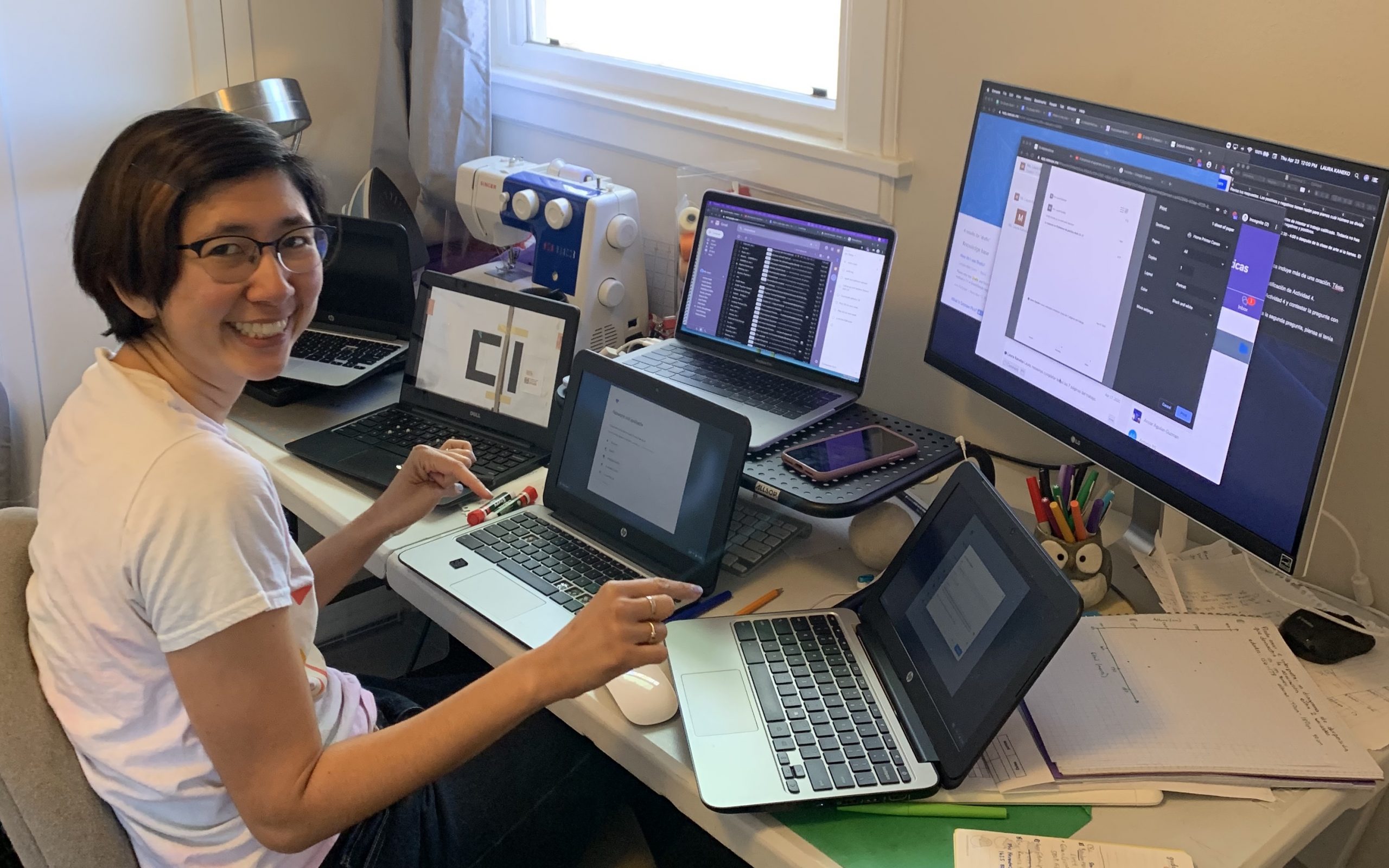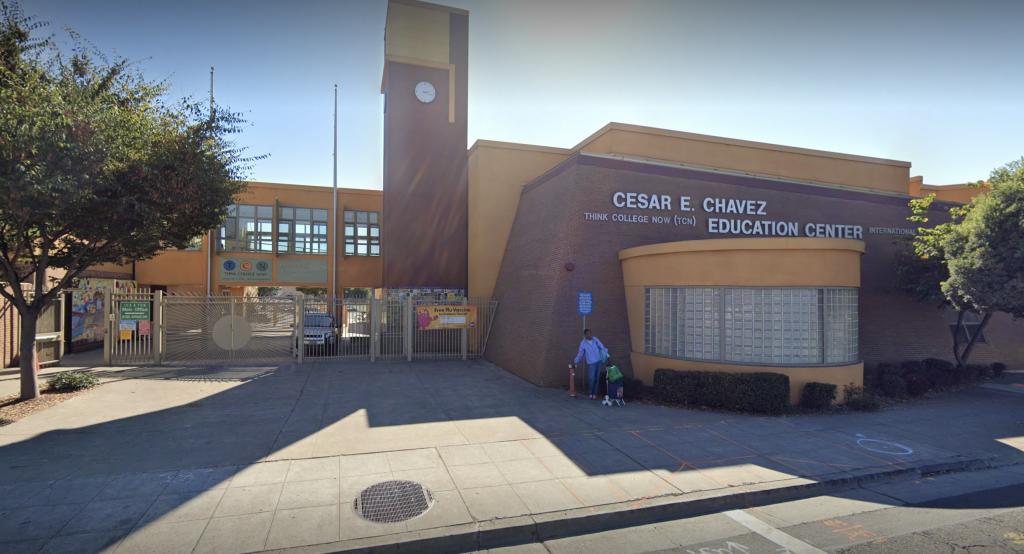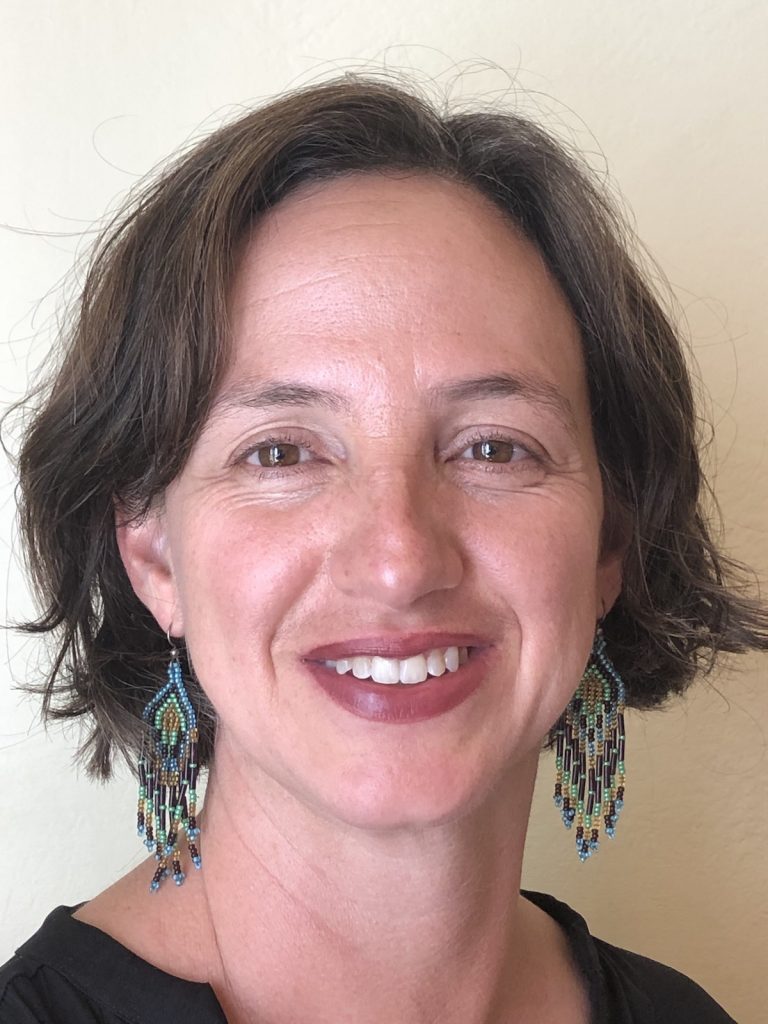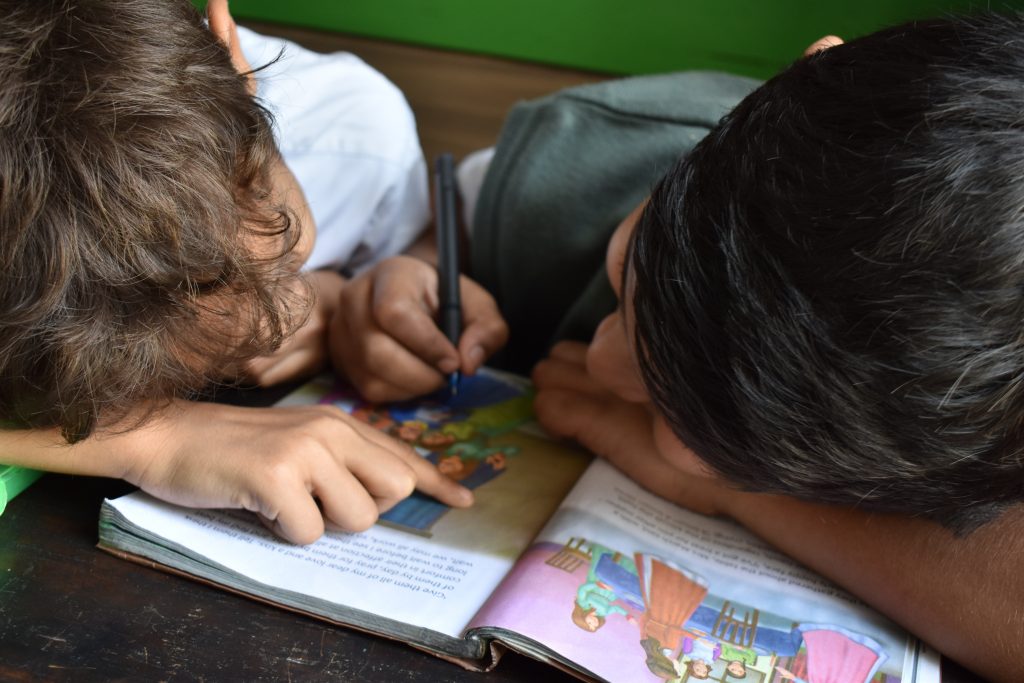
When schools closed on Friday, March 13, teachers in Oakland Unified School District (OUSD) were given virtually no time to prepare for online teaching and they faced many challenges. Now, two months later, many of the challenges continue and are likely to continue into the future, despite massive efforts at the school level to meet the challenges.
Three teachers in East Oakland chatted with Oakland Voices about what it’s been like since schools closed, how some students have yet to have internet access, and how many students do not like online learning.
Think College Now (TCN) is located in the Fruitvale district and has a student body that is low-income and very ethnically and linguistically diverse, and Melrose Leadership Academy (MLA) is a dual-language PK-8 bilingual school located in Maxwell Park that is ethnically and socio-economically very mixed.
Like other teachers, Laura Kaneko, an 8th grade math teacher at MLA, was concerned that closing schools and moving to online teaching would exacerbate existing equity issues related to income and access to technological devices. But health considerations convinced her that schools needed to close. Her colleague Laura Alvarez, an 8th grade English Language Development (ELD) and History teacher at MLA added, “school is such a petri dish.” She was especially concerned for her students and their families, who don’t have a lot of access to healthcare.

As in other schools where many students come from low-income and often newly immigrant households, teachers at MLA and TCN were confronted by huge challenges. They learned that many students did not have access to computers or the internet at home. Many teachers had no or very little experience with online teaching platforms and apps. “I think everybody’s been trying, and scrambling with what they can, but I was frustrated that there was a push to close schools. We were told to send work home for two weeks, to provide online instruction during that time. People should have been given some time to plan thoughtfully,” said Alvarez. “It was a surreal experience,” said Kaneko. “At the time, I knew it would be serious, but I didn’t anticipate being out of school for the remainder of the year,” said Nat Williford, a 3rd grade teacher at TCN.
The schools have continued to try to resolve both human and technological needs. They have been delivering meals, gift cards for food, diapers, and Chromebooks to families. Both schools have started GoFundMe campaigns to raise money for families in need (see below for links).
What’s Been Going Well?
A major challenge, but also something that the teachers are proud of, is that they have managed to get computers into the hands of students. It hasn’t been easy, however, and it has been primarily up to the schools to make this happen. At TCN, all students now have a computer at home, mostly Chromebooks. The school received a donation of two full laptop carts of older computers from San Francisco Unified School District, which a school was going to send to e-waste. “They work great. They’re the same ones that students use in school. Some of them have some wear and tear,” Williford said.
Students at MLA also have computers at home, thanks to the efforts of the school and teachers. In addition to being a 7th grade math teacher, Kaneko is the school’s data and technology lead teacher. She and many other teachers cleaned and checked out 146 Chromebooks to students; this also included delivering them to homes when families couldn’t come to school to pick them up. In addition, a parent donated about 50 used computers that had been scheduled for e-waste, which he refurbished and then installed with a basic operating system and some educational software.
For Williford, one of the “shining lights in the darkness” was how families and students have responded to the computer distribution. “I was just really blown away by the positivity of all the families and the kids that I saw. It was just an amazing reminder of the power of school community and the school as an anchor and as a beacon of hope,” she said. One of her 3rd grade students who moved from Guatemala last year and lives about a mile and a half away from the school walked alone to school, picked up a computer, and walked back home alone as no one in his family was able to come with him.

Teachers talked about unexpected close relationships that they felt they had developed with students during the crisis. For example, Kaneko said that she has developed relationships with more students than she had in the past. In fact, while we were talking on the phone, two students texted her. One student asked, “Are you OK?” Kaneko told me that, in the past, even though she gave students her phone number, very few students contacted her. “I’m hopeful these relationships remain strong whenever we go back to the classroom” she said.
Alvarez also commented on a similar phenomenon. “There are some kids, I actually feel they are more connected right now. And I feel more connected, too, because now I’m mostly engaging with kids one-on-one and in small groups. Kids who could be a little bit more invisible in a classroom, I actually find I’m interacting more with them via text. And they’re consistently coming to the online meetings and they’re consistently doing their work. Maybe for them it’s a less stressful situation,” she said.

“People who go into teaching care about those social relationships. We’re not people that enjoy being locked in a room by ourselves. That collegiality is really important to your sense of being part of a community that’s doing important work together. It’s hard to maintain that sense when everything is online.” – Laura Alvarez, 8th grade English Language Development (ELD) and History teacher at Melrose Leadership Academy.
Photo by Antonio Alvarez
Although not all students have been able to access or engage in online learning opportunities, the teachers have seen some successes. For example, Alvarez said that all of her students have been participating in some or all of the three online learning components of her class (a weekly small group video call with her lasting 30-60 minutes; History/ELD assignments posted on the Seesaw app; and reading on an app). She has also adjusted some parts of the schedule and which apps to use based on feedback from students. For example, instead of holding office hours in the morning, she now holds them in the afternoon because “They’re semi-nocturnal, so I get a lot of postings and text messages at 10 o’clock or midnight!” she said
Despite the difficulties that some students have had getting online, Williford said that whole class meetings online have been working well with her 3rd graders. The meetings used to last for 30 minutes, but she extended them to one hour when she saw how much the students enjoyed them. “That’s been an amazing time. I can tell it’s fulfilling for the students because we’ve had increased participation. About 60% of students come in regularly. I really didn’t expect it to be as strong as it is,” Williford said. The morning meeting is structured like a classroom morning meeting, when students take responsibility for different roles and responsibilities (e.g., greetings; a morning message written by Williford, but read aloud by a student; a game, such as a scavenger hunt—one day a student directed his peers to go find a favorite book; a mental math exercise using an online whiteboard with a shared screen to solve a problem; and writing, when students read their work from the day before and receive feedback).
Another success for Williford has been the writing mini-lessons that she has been videotaping. It appears that students are better able to follow her video lessons than when she taught them in the classroom. She wonders if this is because students can go back and watch the videos and/or because she is more focused when videotaping the minilessons than when she was teaching in the classroom.
How Helpful Has the District Been?
Although these schools have been pretty much on their own with regard to adjusting to online teaching and making sure that students have access to the technological devices and internet that they need, teachers commented on how well the district responded to a potential food crisis among families whose children relied on school breakfasts and lunches. Right away, the district set in place a “Grab and Go” breakfast and lunch program that is available to all OUSD families and any Oakland child 18 and under. Flyers about the program are available in five languages.
Teachers also mentioned that the district has been regularly communicating with students, families, and staff with text and email updates about a variety of resources, including shelter-in-place and where food sites are located. Williford thinks that the district has attempted to support teachers in how to teach online through webinars. For example, she is a representative on a district-wide tech committee and she was one of the leaders of a session for 3rd grade teachers, but only four teachers participated. However, the webinar leaders posted resources and more than 100 teachers have accessed the site. “Maybe it’s not the need of teachers to attend meetings and get all these new tools,” said Williford.
What Hasn’t Been Going So Well?
The teachers reflected on the many challenges that online teaching/learning has presented to teachers, students, and families. A continuing challenge is students not having access to the internet. For example, only about 80% of students at TCN have access to the internet. “That’s been a huge issue,” said Williford. Recently, a donor signed on to cover the cost of WiFi hotspot devices for students who do not have internet access at home.
Although some internet providers are currently offering two free months of internet access, there are often huge hurdles for applicants to overcome in order to qualify. According to the teachers, families have tried multiple times to register for Comcast’s Internet Essentials program, but have encountered many barriers. Alvarez told me about a family who applied for the program. She completed one of the applications, but a week later, the family was told that the picture of the ID needed to be reset, closer up. Also, if approved for this program, it takes a week to ship the modem to the house and then it’s up to the customer to set it up. Williford also mentioned another limitation to the Comcast program: “You can’t sign up for their free WiFi if someone in your household has already signed up, and a lot of our families live in multi-family households,” she said.

According to the teachers, families have tried multiple times to register for Comcast’s Internet Essentials program, but have encountered many barriers.
An additional challenge is the difficulties that online learning can pose for students and this is reflected in participation rates of students. For example, Kaneko said that while some students would see the posted assignments and do them all, others would struggle along and maybe come to the online “office hours.” And still other students haven’t done any of the assignments. Teachers have found that some students have very intense family situations that can affect their participation online. For example, the father of one of Kaneko’s students was in a terrible car accident and was hospitalized after the accident*. A lot of students, including some high-achieving students, also need the kind of support that person-to-person contact between students and teachers in school provide. Kaneko thinks that this lack of in-person support has widened the equity gap.
Although only two of Williford’s 3rd graders do not have access to a device and WiFi, only about 50% of her students participate online. “The biggest barrier isn’t internet and devices anymore. It’s the schedule and supervision at home,” said Williford. Young children often need support in working online and in some cases, both parents are working away from home or are unemployed and are looking for work, so there’s no one to remind them to log on. One parent told her, “My child is so motivated at school, but at home, she’s not doing anything. How do you motivate her in the class?” Other families seem to be overwhelmed and have stopped responding to her messages. She is now working with a colleague to develop a plan to train parents based on their needs and focused on how to best support them with online learning at home.
In schools that have worked hard to develop a collegial, collaborative community of professionals, like MLA and TCN, it appears that online teaching may be undermining it. “Staff at MLA have had a pretty solid community,” Kaneko said. “A lot of us value that as part of working at MLA. Now, we’re all under so much stress and have had such different experiences with this and have different capacity to be engaging in distance learning. It was a lot bigger learning curve for some people than others. We’re doing our best.”** She also pointed out that teachers are in “different spaces” with regard to what they can do. For example, some teachers have young children at home and/or are supporting older parents, whereas other teachers have none of these responsibilities.
Alvarez also commented on this shrinking of the collegial community: “I feel really disconnected from a lot of my colleagues. There’s a small group of grade level colleagues that I meet with regularly. But even meetings over Zoom are just awkward. You don’t get that level of connection of just having lunch together every day in the lunchroom. I think people who go into teaching care about those social relationships. We’re not people that enjoy being locked in a room by ourselves. That collegiality is really important to your sense of being part of a community that’s doing important work together. It’s hard to maintain that sense when everything is online.”
Challenges to Classroom Community

A similar decline in the sense of community that had been built in classrooms before school closure concerns the teachers. “My class this year made so much growth and came into this beautiful community. And to have that go away and to feel that I haven’t figured out how to get that back keeps me up at night,” said Williford.
Alvarez is also concerned about this diminished sense of community and connections among students. “For kids, a lot of why they come to school is to see friends, and that’s much harder online. They like getting to see each other in the video calls, but the interaction is awkward. They don’t have free time at recess to just hang out. So, I feel some of them may feel pretty socially isolated,” she told me.
What Do Teachers Say They Need?
During interviews with the three teachers in early April and then recently, a major need remained the same—time. In early April, they said they needed time to: a) connect students with online learning and apps, and b) communicate with other teachers and learn about what their colleagues were doing and using.
Now, the teachers say they need time for other activities, including time to schedule more calls to individual students and hold more small group conversations. And, time to balance things. “This is really hard. It’s really hard for me to be looking at a screen from 8:30 to 5:30,” said Kaneko.
Williford is also encountering difficulties balancing her time and figuring out where to put her energies. For example, she has limited time for phone calls and asks herself whether she should make a phone call to a student who is engaged or to another student who does not appear to be engaged. Should she put her time during the day into conferring online and teaching students who are engaging or should she be driving to peoples’ home to help them with technology issues? She knows they are all important tasks, but she doesn’t have time to do them all.
What Do Students Think About Online Learning?
According to these teachers, many of their students aren’t too keen on online learning. Alvarez’ students have repeatedly said to her, “I’m bored,” “I miss my friends,” and “I miss school and being around people.” Students tell Kaneko that it’s hard keeping track of what they should be doing each day. She read a text to me from a student who was feeling overwhelmed that said, “Maestra (Teacher), I’m not confident or comfortable doing the grade level work.”

However, some students like not having to deal with the stress that middle school can generate. Kaneko told me that one student had said, “Wow! I’m actually kind of glad that we’re not in school. Too much drama!”
There are also students who seem to do much better than expected in this kind of situation. For example, one of Williford’s 3rd graders who came from Guatemala one week before school closure has been engaged. “It reminds me that people are so resilient, especially our immigrant communities,” she said.
Do These Teachers Think that Online Teaching Is Something that Districts Should Be Doing More of?
“No!” the teachers responded emphatically. “It’s hard to think about it outside of the context of this pandemic. The equity question is just so big. No. Because unless we have high speed internet in every home. Unless you can address the issues of poverty,” said Kaneko. She then read a text sent by a student at 6 p.m. on a recent day explaining that she hadn’t been able to join “office hours” because her mother had to work late and she had to take care of her siblings.
Even when students have had access to a computer, there have still been huge issues to address. For example, a challenge for teachers of younger students was whether it is appropriate to assign schoolwork that requires a lot of time in front of a screen. Kaneko has been told by primary grade teachers, “We teach little people and we can not be recommending that they spend hours at a time in front of a screen. It’s against what we believe in.”
Williford is also not in favor of long-term online teaching. “I feel some days motivated by all those positive bright spots I was sharing with you. Generally speaking, it’s a really dissatisfying way to teach. It’s not what I love about teaching. It’s not what I signed up for in teaching. It’s really sad for a lot of my students. And I hope it ends soon,” said Williford.
Alvarez has also seen how online teaching has its limitations. “It’s a necessity. I wouldn’t opt to teach this way, but I think we’ve been able to figure out a way to adapt,” she said. “I just don’t think it’s as engaging and interactive. I think there are certain apps that are useful. Like ST Math (a visual math program), but a lot of teachers were already using it in their classrooms. I think there is a role for doing things online, but I think that we’re doing enough and don’t think that kids need to spend more time doing that,” she told me.
What Are the District’s Plans for the Future?
Given the nature of COVID-19, it is unclear when schools may reopen. According to OUSD’s website, the district is planning on some form of a summer program for students in greatest need through online learning, but no details are available. The website also indicates that the district expects to begin the 2020-2021 school year on August 10, but many questions remain: Will there be shifts, staggered classes by grade level? How will social distancing be maintained, particularly with very young children? Will masks be required? Will students and staff have their temperatures taken upon entry to schools? Will online teaching and learning remain the norm? (The district did not respond to a request for an interview).
Teachers are concerned about what kind of planning the district is engaging in for the future. For example, Alvarez expressed the hope that decisions will be made with considerations for public health in mind. She is concerned that the governor will move too quickly and there’ll be an outbreak of COVID-19. “It would be worse to reopen and then close and have this kind of craziness again in the Fall,” said Alvarez
Teachers also urged the district to plan carefully for online learning that everybody has access to, if schools do not reopen in the fall. Alvarez is particularly concerned that any planning for future online teaching must take into consideration what is known about principles of good teaching and learning, and time for teachers to plan thoughtfully.
+ + +
GoFundMe links for Melrose Leadership Academy and Think College Now:
Covid-19 Relief for MLA Families
CWFL x Think College Now Charity Kickball
*One detail was taken out from the original version of the sentence to protect the identity of the family.
*The quote from Kaneko has been updated to reflect the current situation.
Katharine Davies Samway has lived in Oakland for over 35 years. She is a long-term educator — a teacher, a researcher, a teacher educator, a professor of education.




What a thoughtful and informative piece. Thank you for telling both how amazingly teachers are adapting to the current “normal,” as well as to including some of their concerns. This is a wonderful reminder to value public education and to appreciate our teachers.
Well said.
Wow, This was a very detailed article about the days in a life of two Oakland OUSD teachers. I have been trying to find news on teachers – this is the first to really get down and explain that – the teachers are like on the front lines – almost like first responders – because life for the kids has to go forward. I admire the the strength and resiliency of the teachers.
Excellent and illuminating article! Great coverage of teacher’s and student’s feeling about learning in this pandemic.
Excellent article, captures the challenges of online teaching…the shortcomings for the students and the angst of the teachers despite their heroic efforts to teach online.